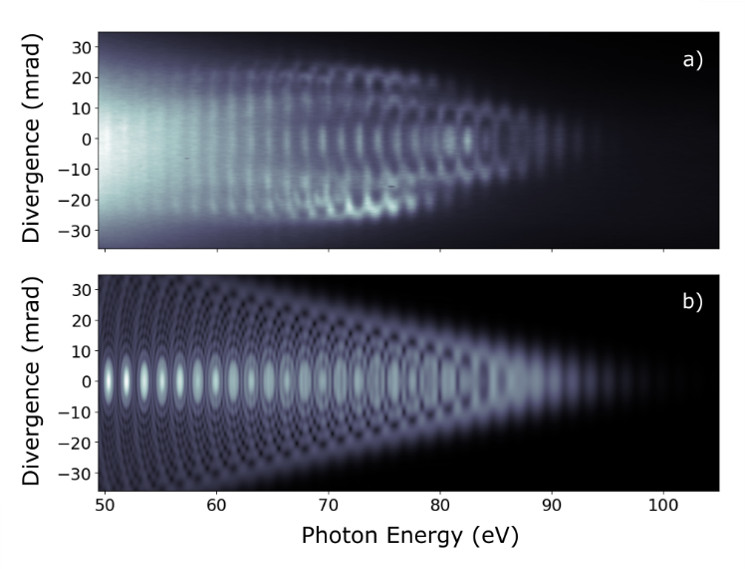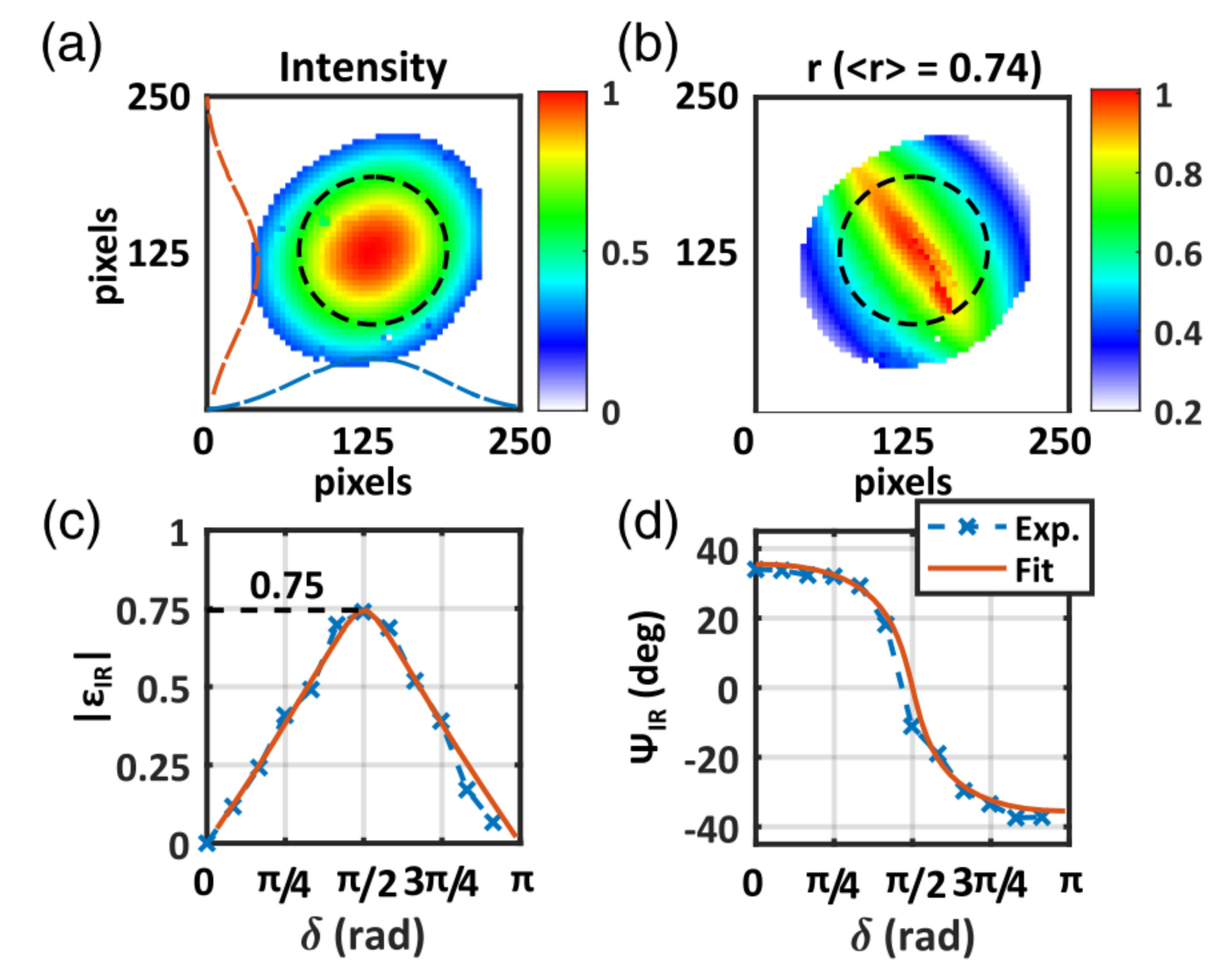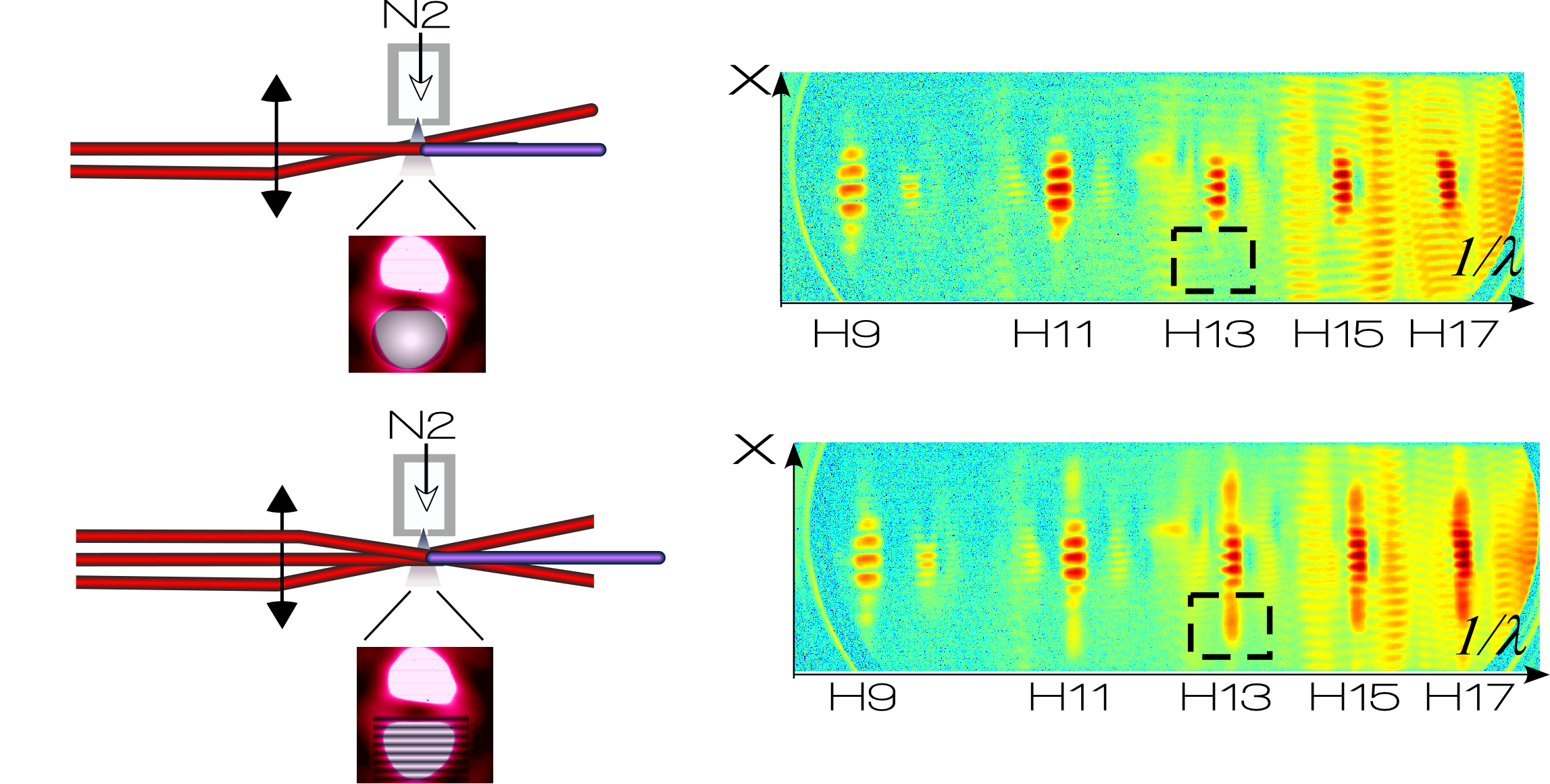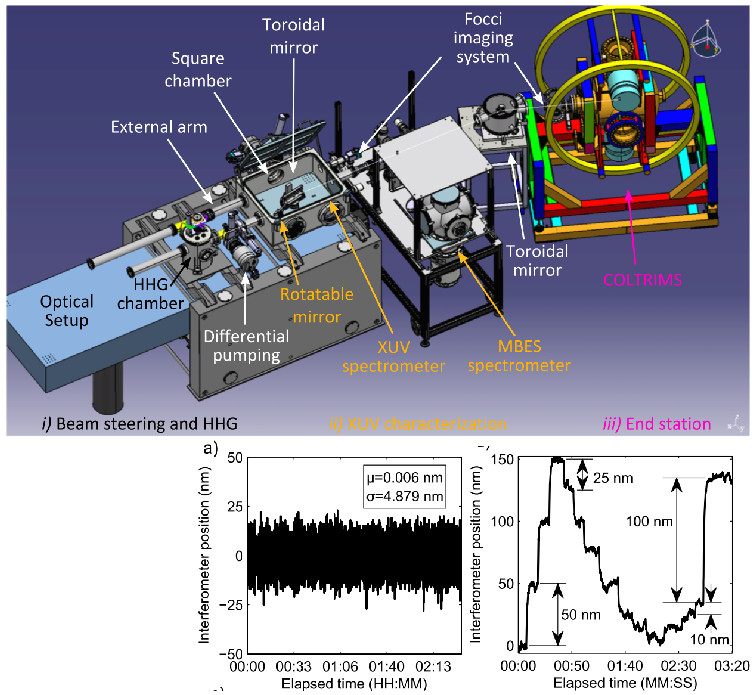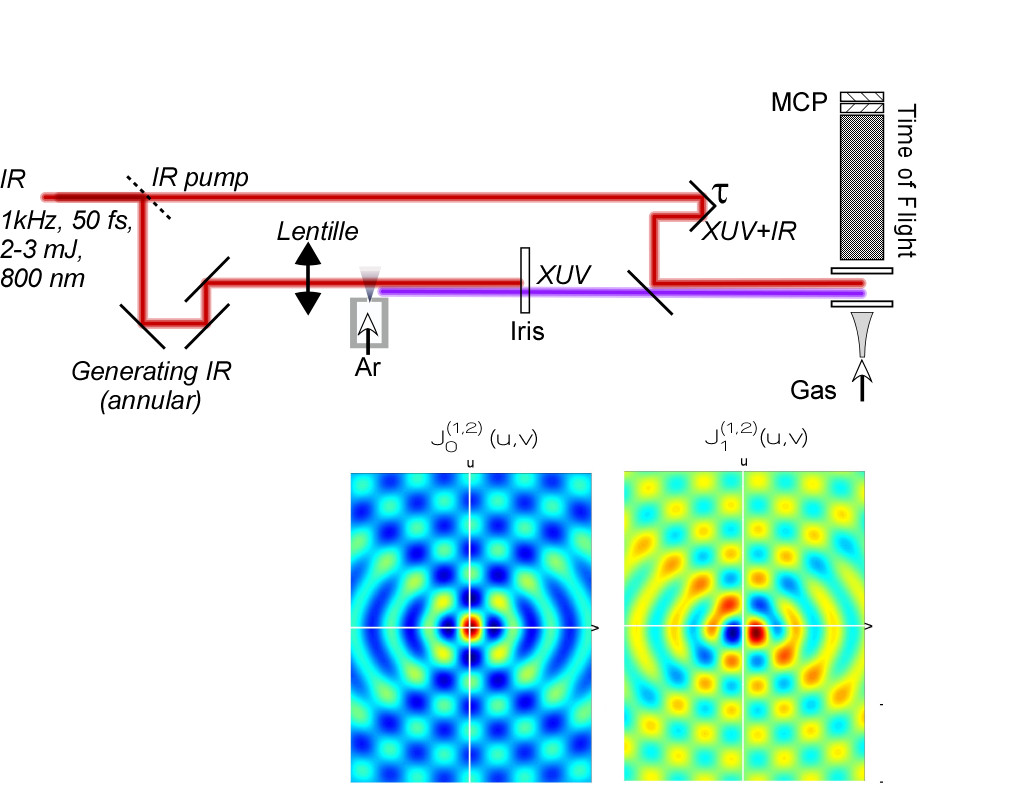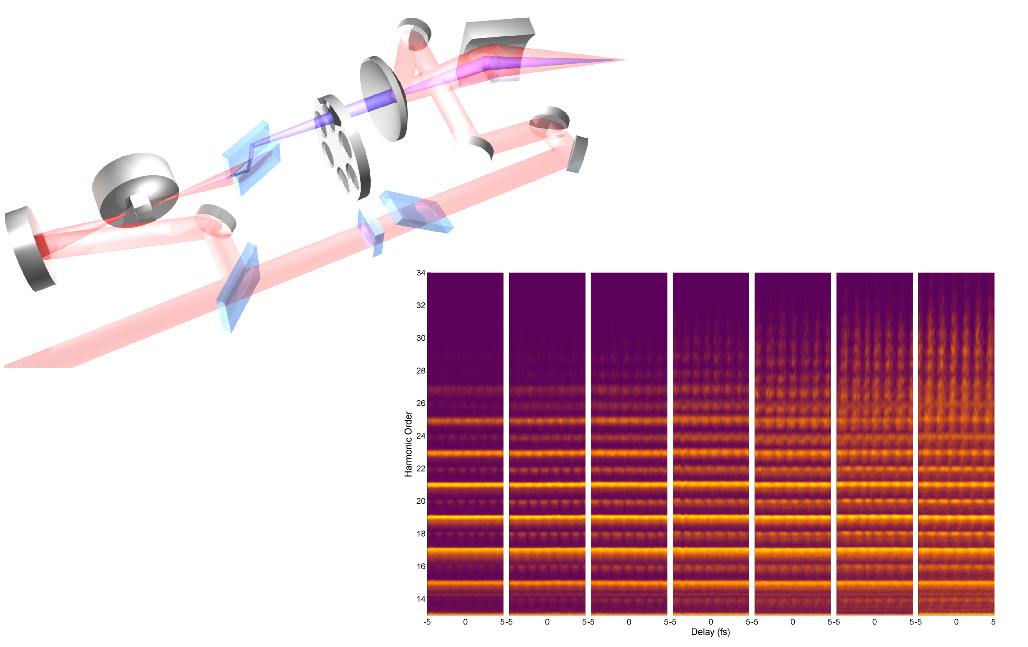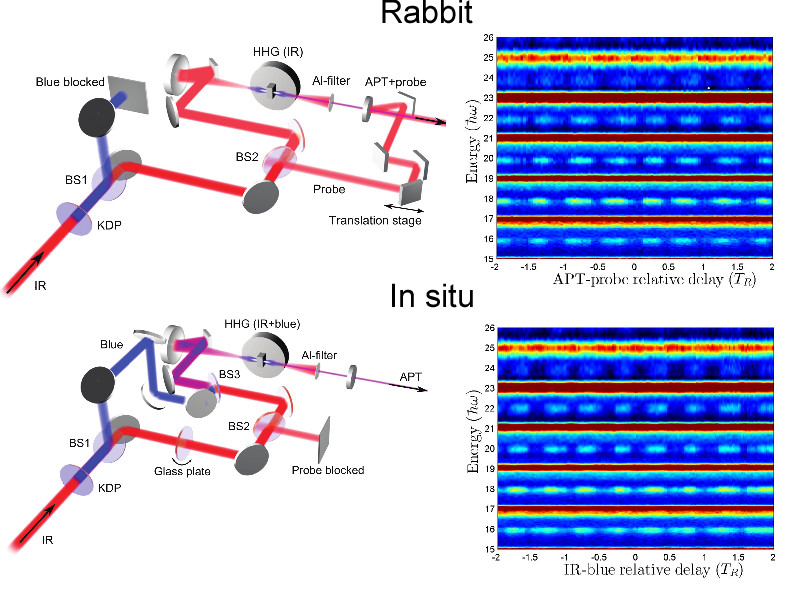
HHG at high repetition rates
HHG requires a high peak electric field at focus. In addition, short durations favor the obtention of high cutoff energies. With these requirements, the dominant laser technology has been based, over the past 20 years, on Ti:Sapphire crystals inserted in a Chirped Pulse Amplification scheme. They can reach high average powers (tens of watts), but their repetition rate remains limited to 10 kHz maximum, most often 0.1-5 kHz. Recently, a new technology able to fullfill these requirements emerged. It is based on Ytterbium Doped Fiber Lasers, and works at much higher repetition rates (beyond 100 kHz). It may be extremely advantageous for a great wealth of applications, including coincidence spectroscopy (see XUV Spectroscopy.).
Through a collaboration with the group of Marc Hanna, at LCF (Institut d’Optique Graduate School, Palaiseau), we could test HHG with such a laser. The experiment was carried out at LCF. Using the fiber laser to seed an Optical Parametric Amplifier (OPA), we could investigate HHG at high repetition rate and long wavelength (1500 nm). We connected the appearance of very strong spatial and spectral modulations in the spectrum to the high sensitivity of the dipole phase during HHG to the laser intensity at this wavelength (see figure). This strong dependence make the use of such long wavelengths difficult to handle. However, the exceptionnal stability of the laser still make it very attractive for future applications.
Fast ellipticity modulator
For some applications, in particular to study dichroims in the XUV spectral range, it would be interesting to be able to modulate the polarization of the harmonics extremely rapidly. As the harmonics polarization follow that of the driving laser, a first approach is to simply place a rotating quarter wave plate in front of an HHG setup. However, this is inherently slow, with a modulation rate that will remain confined below 1 Hz.
We demonstrated the possibility to modulate much faster this polarization state by creating an equivalent quarter wave plate based on an interferometric scheme. Two orthogonal polarization propagate in two arms of an interferometer, before being recombined. Depending on the delay between the two paths, the ellipticity of the recombined beam can be fully adjusted. The important point is that a 400 nm displacement, which can be extremely quick to make, suffice to reverse the ellipticity (figure).
We demonstrated this ellipticity control by measuring the polarization of HHG radiation driven by this composite beam. We retrieved the same laws as with a regular quarter waveplate, proving the validity of our approach.
Towards single shot polarimetry of XUV beams
Combining two approaches for harmonic spectroscopy, we proposed a new protocol for polarimetric measurements of HHG beams. We used the N2 linear molecule as a gas target for HHG. When aligned with respect to the laboratory frame, HHG radiation from N2 may be elliptically polarized, with a principal axis of the ellipse turned with respect to this frame. It was long known that these molecules can be aligned with a first « pump » beam.
The first technique we used is the two source technique developped in particular in our group (see below). It yields an harmonic spectrum with fringes, as illustrated in the figure. Now, instead of pumping one of the source with a homogeneous beam, we pumped it with a beam showing a periodic intensity. The molecules were then periodically aligned, in a grating configuration. As a result, extra diffraction peaks were observed (see figure).
The experiment was carried out in CELIA-Bordeaux with Yann Mairesse et al. We noted that the two techniques used simultaneously could inform on both orthogonal components of the XUV radiation, leading in fine to a possible single shot polarimetry of the XUV radiation.
Flexible attosecond beamline for high harmonic spectroscopy and XUV/near-IR pump probe experiments requiring long acquisition times
In this article we review the capabilities of our attosecond beamline coupled to the PLFA laser run by the SLIC team. . This beamline is designed to provide the most complete diagnosis set of HHG radiation. Turning a flat mirror we can perform polarimetry measurements, two sources measurements (see next highlight), and RABBIT measurements. In addition, through a collaboration with the group of ISMO , a coincidence imaging spectrometer was coupled to this line. It comes as a second in raw spectrometer, after a Magnetic Bottle Electron Spectrometer, used to perform RABBIT measurements
A great deal of work as been carried out to passively and actively stabilize the delay between the XUV beam and a synchronized IR beam. The result is a synchronization of about 10 nm stable over hours, which can be adjusted by 10 nm steps. This was mandatory to perform coincidence measurements on this KHz laser. Such measurements were reported in Picard et al., Phys. Rev. A 89, 031401(R) (2014) and Billaud et al, J. Phys. B: At. Mol. Opt. Phys. 45 194013 (2012)
An ultrastable XUV interferometer for attosecond physics

Related publications:
We developed a new XUV interferometric scheme with unprecedented stability, opening up numerous exploration prospects in attophysics. The device developed holds stability from its extreme simplicity: a 0 phase mask, that is to say, a silica plate whose one half was precisely ablated with a thickness providing a phase shift of
between the upper and lower portions of the beam, is placed on a Gaussian intense laser beam. This beam, when focused, gives two intense focal tasks (see figure). The intensity of the laser beam is selected to generate attosecond pulses in a medium placed in these areas of high intensities. Coming from the same laser with no division interferometer, they are perfectly stable with respect to each other. One of the target only is « pumped » by an extra laser beam. Thus, the attosecond radiation from two sources, one pumped, the other not, interfere in the far field . This interference pattern, which gives the relative phase between the two sources, carries information about the HHG process. We have studied this device both theoretically and experimentally, getting an excellent agreement. For example, we studied the influence of the alignment of molecular samples on the HHG emission.
See also the corresponding « Breve Iramis ».
Measurements with the RABBIT scheme
An important measurement for attosecond science is that of the spectral phase of the radiation. Indeed, although the spectrum supports attosecond pulses, would the spectral phase accross the spectrum be random that no attosecond pulse would be obtained. This measurement has long constituted a major challenge in the community. It was finely solved in 2001 simultaneously in the group of Ferenc Krauz in Vienna and in our group in Saclay, through the use of a cross correlation technique between the XUV beam to be characterized and part of the remaining IR from the HHG process. The two « dressing » regimes explored in these pioneering experiments, i.e. the intensity of the dressing IR (« streaking » or « RABBIT » regimes), were later unified by Fabien Quéré and Yann Mairesse in the FROG-CRAB formalism
In this paper, starting from the FROG-CRAB equations, we derive the detail of the RABBIT technique and give practical hints on the way to be in the correct « perturbative » regime.
Intensity dependence of temporal measurements of attosecond pulses with the RABBIT technique (work carried out in Lund)
The measurement of attosecond pulse trains temporal structure may be carried out with the RABBIT technique. It basically consists in a cross correlation between the XUV pulse to be characterized and a finely delayed IR beam, that is superimposed with the XUV beam in a gas target placed in the sensitive region of an electronic spectrometer. Instead of measuring a comb of electron energies equally spaced, mapping the harmonics’ energy comb, a series of extra « sidebands » are observed, due to two photon processes (XUV+IR). The yield of the sidebands depends on the precise delay between the XUV and the IR. In the RABBIT regime, this dependence should be a pure cosine function with half the period of the driving laser, whose phase reflect the phase difference between successive harmonics. In this article we show that increasing the intensity of the IR, extra frequency components may be obtained, and that the retrieved spectral phase is no longer accurately mapping the group delay of the harmonics.
Measurement of the macroscopic and microscopic HHG phase (work carried out in Lund)
When perturbing HHG driven by a laser at angular frequency by a second weak field at frequency
, in addition to usual odd harmonics, even harmonics are also generated. This comes from the non equivalent total electric field seen by the atoms for two successive extrema (a minimum and a maximum) of the
field. The periodicity of the HHG process is thus now
, twice as much as in the standard case when two successive extrema are almost exactly identical. The yield of these even harmonics strongly depends on the phase of the recombining electron. It was proposed that measuring this yield provides a measurement of the spectral phase of the emission (N. Dudovich et al., Nat. Phys. 2, 781 (2006). ).
In this paper we compared the results of measurements carried out with this technique with measurements with the traditional RABBIT technique. We show that the two are not measuring the exact same thing: the first is measuring the phase of the radiation at the microscopic level, as it is emitted from a single atom, while the RABBIT measurement yields the spectral phase of the total harmonic field, that progressively builds by the addition of all atomic contributions. The latter thus includes phase matching effects. These effects were identified varying the generating pressure of the gas target.



